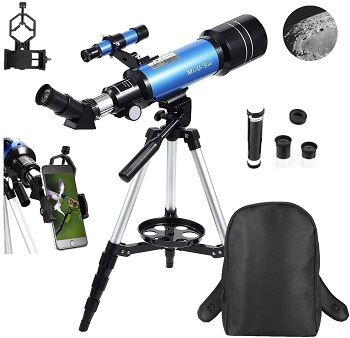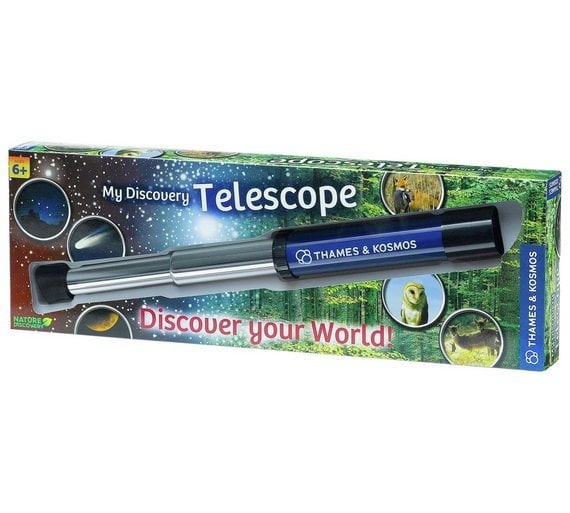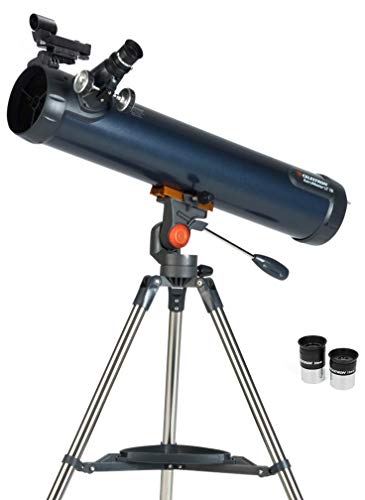


The aperture of a telescope for kids is an important consideration. Many telescopes for kids come with eyepieces with different focal lengths designed to view different objects. For kids’ telescopes, this ranges from 4 to 35 millimeters.

It also magnifies the image, and its focal length is measured in millimeters. The eyepiece (ocular) on the telescope is the part through which your child views the images. (A telescope's field of view is the visible landscape through the telescope's eyepiece.) Eyepiece The longer the focal length, the shorter the field of view and the greater the magnification. Telescopes for adults can be as large as 3,000 millimeters. This is measured in millimeters and ranges from 300 to 700 millimeters for kids’ telescopes. The focal length of a child’s telescope is the distance that light travels from its entry point (aperture) to the focal point (the focuser nearest the eyepiece). That means that for a 70-millimeter aperture, the highest magnification for clear images would be 140x. The general rule for useful magnification in telescopes is that it doesn't exceed double the telescope's aperture in millimeters. For example, 50x magnification means the lens magnifies the object 50 times its size seen with the unaided eye. These telescopes typically have magnifications of 20x to 50x, and up to 200x, with x being the size of the object viewed with the unaided eye. The magnification of kids’ telescopes tells you how much larger the object you’re looking at will appear. One of these might be easier for a child to start out with, but they’re more limited in their height and angle adjustments.īestReviews Features to look for in telescopes for kids Magnification While many kids’ telescopes mount on a tripod, there are also tabletop telescopes. Toy telescopes are designed for very young children around the ages of 3 to 6. Toy telescopes are largely made of colorful plastic, and while they have some magnification, they aren't capable of viewing objects at any great distance. It's important to note that telescopes for kids are not toys. Some simpler telescopes might be suitable for younger children ages 5 to 7 if they have the help of an older sibling or adult. Most kids’ telescopes are geared for children ages 8 to 12.

However, compound telescopes cost more, and large ones can be quite heavy. They produce the clearest visuals and often incorporate computerized tools that make them quite user-friendly. They aren’t suitable for viewing closer objects on Earth.Ĭompound (catadioptric): These telescopes combine elements of both reflector and refractor telescopes, using both lenses and mirrors to collect light and magnify the image. Reflector telescopes are ideal for viewing planets and distant objects in deep space, such as nebulae and galaxies.
#Kids telescope reviews free
The mirrors are able to collect more light, producing clear images that are free of chromatic aberrations. Reflector: Reflector telescopes use a set of curved mirrors and a single lens to produce a magnified image. However, these telescopes are the most susceptible to false color, or chromatic aberration, that can cause halos around objects. Refractor telescopes are best for viewing closer objects in the sky and on Earth and are the most common type of telescope for children. They include a long tube and lenses that focus the image in the eyepiece. Refractor (refracting): These telescopes are the simplest. There are three main kinds of telescopes for kids: refractor, reflector, and compound. If they’re more interested in observing things like birds, trees, and wildlife, perhaps a pair of affordable binoculars would be a better choice. What your child is most passionate about viewing has a big impact on the telescope you choose. Do they want to view the moon and planets in our solar system? Is your kid more interested in nebulae and other distant galaxies? Would they prefer to look at mountain ranges or other terrestrial features from far away?
#Kids telescope reviews how to
How to buy the best telescope for kids PurposeĪn important factor when choosing the best telescope for kids is figuring out what your child wants to look at. If your child shows a keen interest in astronomy, you might want to buy a mid-range telescope that can be upgraded with accessories.


 0 kommentar(er)
0 kommentar(er)
